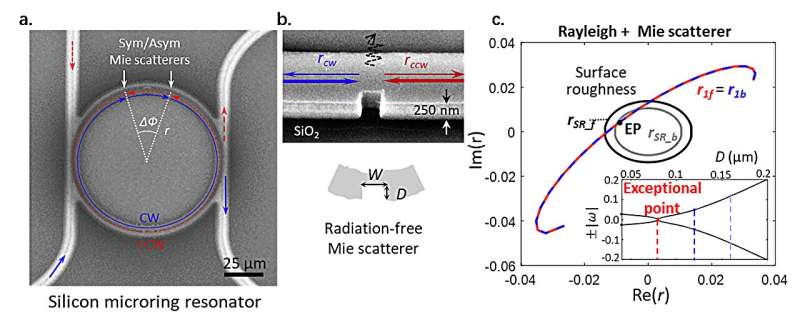by Light Publishing Center, Changchun Institute of Optics, Fine Mechanics And Physics, CAS

Non-Hermitian systems with their spectral degeneracies known as exceptional points (EPs) have been explored for lasing, controlling light transport, and enhancing a sensor’s response.
A ring resonator can be brought to an EP by controlling the coupling between its frequency degenerate clockwise and counterclockwise traveling modes. This has been typically achieved by introducing two or more nano-tips into the resonator’s mode volume.
While this method provides a route to study EP physics, the basic understanding of how the nano-tips’ shape and size symmetry impact the system’s non-Hermicity is missing, along with additional loss from both in-plane and out-of-plane scattering. The limited resonance stability poses a challenge for leveraging EP effects for switches or modulators, which requires stable cavity resonance and fixed laser-cavity detuning.
In a paper published in eLight, a team of scientists, led by Professor Tingyi Gu from the Department of Electrical and Computer Engineering, University of Delaware, U.S., and co-workers have developed lithographically-defined asymmetric and symmetric Mie-scatterers.
This enables subwavelength control of wave transmission and reflections without deflecting to additional radiation channels. They show that those pre-defined meta-units can bring the system to an EP without post-tuning and enable chiral light transport within the resonator.
Counterintuitively, a geometric defect, named meta-unit, results in an enhanced quality factor measured on the transmission port by coherently suppressing the backscattering from surface roughness.
The proposed device platform enables pre-defined chiral light propagation and backscattering-free resonances needed for various applications such as frequency combs, solitons, sensing, and other nonlinear optical processes such as photon blockade, and regenerative oscillators
The scientists say, “Our work not only opens a new direction for chiral silicon photonics but is also significant for the following four reasons. First, it reveals the critical role of spatial asymmetry of the nano-tip and Mie scatterers for bringing the system towards EP. Second, the scatter geometry-controlled pathway of driving the non-Hermitian system towards and away from an EP is illustrated in detail.”
“Third, our system is mechanically stable. It allows reliable comparison between transmission and reflection spectra for the perturbed micro-resonator, which reveals the nano-tip/scatter’s contribution to the diagonal terms. This is in contrast to the conventional way of achieving EP with two nano-tips. Fourth, enhancement of the empirical quality factor extracted from the transmission spectra is demonstrated for the first time.”
More information: Hwaseob Lee et al, Chiral exceptional point and coherent suppression of backscattering in silicon microring with low loss Mie scatterer, eLight (2023). DOI: 10.1186/s43593-023-00043-5
Journal information: eLight
Provided by Light Publishing Center, Changchun Institute of Optics, Fine Mechanics And Physics, CAS

